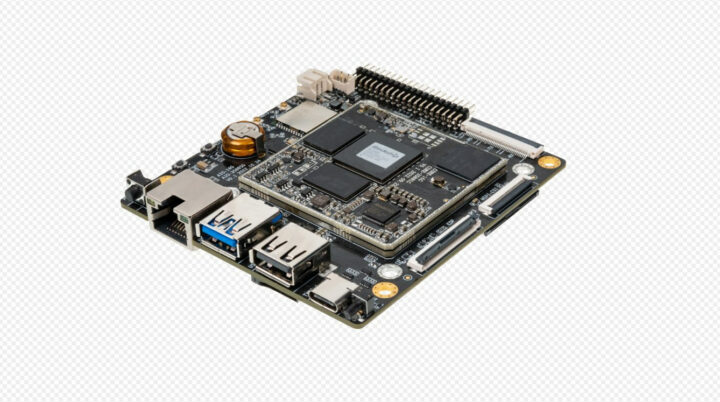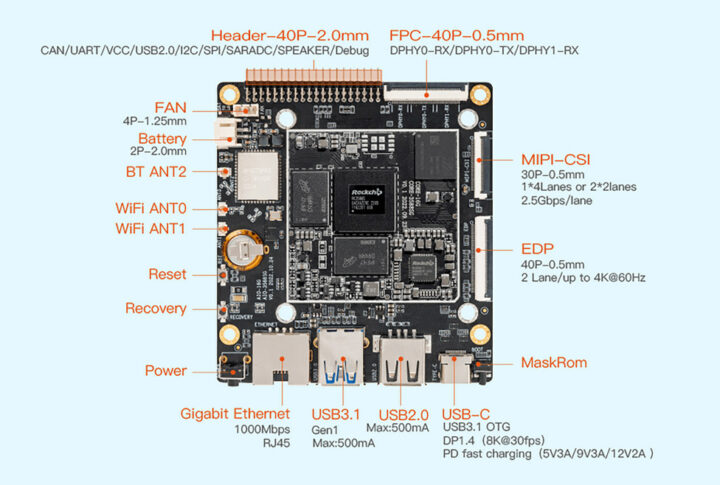Firefly AIO-3588SG is a compact, low-profile SBC with Gigabit Ethernet, WiFi 6, and an 8K capable USB-C port with DisplayPort that is based on the company’s Core-3588SG module powered by a Rockchip RK3588S octa-core Cortex-A76/A55 processor with up to 32GB RAM and 256GB eMMC flash.
The board is designed to be as thin as possible and includes a low-profile RJ45 Ethernet jack which should make it suitable for projects and products that require high performance in a thin form factor such as robotics, digital signage, virtual reality headsets, etc…
Firefly AIO-3588SG specifications:
- System-on-module – Firefly Core-3588SG with
- SoC – Rockchip RK3588S octa-core processor with 4x Cortex-A76 cores @ up to 2.4 GHz, 4x Arm Cortex-A55 cores, Arm Mali-G610 MP4 GPU, 6 TOPS NPU, 8Kp60 video decoder, 8Kp30 video encoder
- System Memory – 4GB, 8GB, or 16GB (32GB optional) 64-bit LPDDR4, LPDDR4x, or LPDDR5
- Storage – 16GB, 32GB, 64GB, 128GB, or 256GB eMMC flash
- PMIC
- Dimensions – 50×50 mm
- Video Output
- DisplayPort 1.4 (USB-C) up to 8Kp60
- MIPI-DSI connector up to 4Kp60
- 2-lane eDP 1.3 connector up to 4Kp60
- Up to three independent displays
- Video Input – 30-pin 4-lane or 2x 2-lane MIPI-CSI connector
- Audio – 4-pin for speaker (on 40-pin GPIO connector), digital audio via DisplayPort
- Networking
- Low-profile Gigabit Ethernet RJ45 port
- Dual-band WiFi 6 (802.11 a/b/g/n/ac/ax) and Bluetooth 5.0 module (AP6275) with 2x WiFi antennas, 1x Bluetooth antenna
- USB
- 1x USB 3.1 Gen1 port
- 1x USB 2.0 Type-A port
- 1x USB Type-C with DP 1.4, OTG, PD fast charging support
- 1x USB 2.0 interface via the 40-pin GPIO header
- Expansion
- 40-pin GPIO header (2.0mm pitch) with CAN bus, UART, USB 2.0, I2C, SPI, SARADC, speaker, debug, VCC, GND
- 40-pin FPC connector (0.5mm pitch) with DPHY0-RX, DPHY0-TX, DPHY1-RX
- Misc
- 4-pin fan connector
- Reset and Recovery buttons
- Power and MaskRom buttons
- RTC with battery
- Power Supply
- 12V (±5%), 2.5A and up via USB-C port (USB PD power adapter is recommended)
- 2-pin battery connector
- Power Consumption
- “Max.” – 15.6W (12V/1.3A) under load, but I assume without peripherals…
- Normal – 5W (12V/0.42A)
- Min. – 0.18W (12V/15mA)
- Dimensions – 88 x 81 mm
- Weight – Around 71 grams
- Temperature Range – Operating: -20°C to 60°C; storage: -20°C to 70°C
- Humidity – 10%90% (non-condensing)
Firefly will provide Android 12.0, Ubuntu, Debian 11, Buildroot, RTLinux, and Kylin Linux support for the Core-3588SG system-on-module and the AIO-3588SG SBC. It’s one of the thinnest Rockchip RK3588S SBC, albeit not quite as thin as the Khadas Edge2 which lacks Ethernet and a GPIO header, and also occupies a smaller area (82 x 57.5mm), but offers fewer I/Os. Firefly hasn’t shown a cooling solution yet although we can see mounting holes for a heatsink, and the Khadas Edge2 is only 11mm thick with a heatsink.
Firefly does not have availability and pricing information for the AIO-03588SG low-profile 8K SBC and the company only says “this product is still not available yet but you can buy it later in Firefly Store”. Additional information may be found on the product page.

Jean-Luc started CNX Software in 2010 as a part-time endeavor, before quitting his job as a software engineering manager, and starting to write daily news, and reviews full time later in 2011.
Support CNX Software! Donate via cryptocurrencies, become a Patron on Patreon, or purchase goods on Amazon or Aliexpress







Now if you could make a keyboard or laptop suitable long strip version board. At a affordable price.
That would wake up the market for Linux keyboard, laptop, desktop pc. IMO
Firefly are making some interesting stuff again at the moment. Also doing a SOM/AIO for the RK3588M. Rockchip seem to be throwing a lot into targeting Automotive market currently (thankfully).
Interesting board! One thing I noticed: The ethernet port is shorter than the USB ports. Is there an RJ45 like that with magnetics, are they hiding the big chunky part on the bottom or is there some other solution?
The Ethernet port looks somewhat similar to the one used on Khadas VIM4: https://www.cnx-software.com/2021/10/21/khadas-vim4-amlogic-a311d2-sbc/
There should be a separate chip on the bottom.
That’s a typical short MagJack (RJ45 connector with integrated magnetics): https://duckduckgo.com/?q=magjack&t=h_&iax=images&ia=images
As such quite the opposite of low-profile 🙂
We can see some of the pins from the RJ45 jack in the photo. Most jacks have pins beneath them so we don’t see them when soldered. It also seems silly to design a board with low-profile connectors, except for the Ethernet jack…
I’ve tried to ask on Twitter, but so far they don’t understand my question. I’ll keep trying 🙂
> It also seems silly to design a board with low-profile connectors, except for the Ethernet jack…
Hehe. Years ago when FA was working on the upcoming NanoPi NEO2, I suggested them to have a look at low-profile recessed connectors to allow to make a thin board (like the mirabox for example by then). It’s not easy on such tiny boards because that removes some PCB space that can really be critical for routing, but if it allows to make everything thinner it’s worth trying. They managed to place the connector like this but they couldn’t find a USB recessed connector that could fit, so in the end you had a low-profile ethernet and a much taller USB side-by-side, making even the enclosure look odd, and finally not saving any space at all. This was later fixed in the LTS model by going back to a regular ethernet plug. Too bad, because thin boards are really nicer, especially with the heat sink at the bottom where there’s definitely a few millimeters to be saved. The VIM boards are great for this, for example.
Unless its old stock clearing in the Intel world, then Arm should worry. More and more low power 6W dual Ethernet devices are available below $99 dollar’s. If someone adds GPIO to these, then why buy RPI or etc. The Intel Linux works. Unlike Arms Linux Cluster fcuk. Even others are noticing it 🤔🤐.
Because you don’t want to buy from a company that backdoors every product.
You really think all the fabbed Arm SoC aren’t backdoored in silicon lol lol 😏😄
I got a new photo (now the first photo in the post), so we can confirm they used a low-profile Ethernet port.
Yay no HDMI and DisplayPort, We are getting there folks 🙂
Their ‘other’ RK3588 SoM is $399, so no – hard pass.
https://www.firefly.store/goods.php?id=176
The AIO board for the old module is only $539 – the price of a mid grade modern laptop.
You should finally begin to learn that when someone is subsidizing a product to be cheaper, they are not doing it because they are your friend.